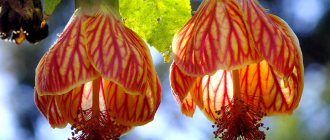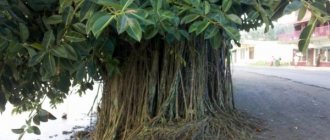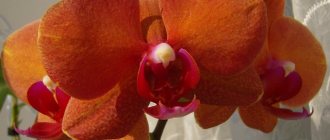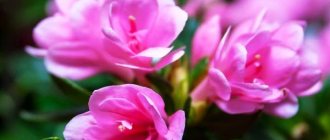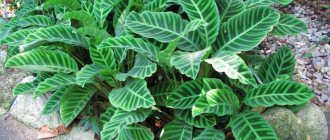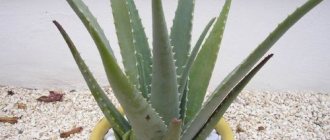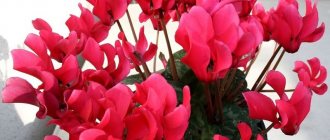There are rumors among flower growers about the capriciousness of plants of the arrowroot family. But are they always justified? Perhaps they just don’t like being forgotten about? After all, everyone needs care
Hello, friends! I have already written about decorative deciduous indoor plants, and today I want to talk in more detail about the arrowroot family, about these tropical sissies, namely, arrowroots, calatheas, stromanthus and ctenanthus.
These beauties with thin, delicate leaves covered with bright patterns attract the attention of many gardeners, but not everyone decides to purchase them. Why? Let's figure it out together.
Caring for tricolor arrowroot at home
Due to the difficulty of fulfilling all the requirements of arrowroot, flower growers consider this crop to be capricious.
But if you find an approach to the flower, it will respond with rapid growth, the constant appearance of new tricolor foliage and even flowering. Compared to the leaves of the tricolor arrowroot prayer plant, the photo of its flowers does not cause a storm of admiration. Some gardeners do not even suspect that their favorite forms spike-shaped sparse inflorescences with whitish or lilac small flowers rising above the rosette of leaves.
Caring for tricolor arrowroot at home must include:
- watering;
- feeding the plant in spring and summer;
- spring transplants carried out at two-year intervals;
- hygienic treatment of foliage from dust and removal of dead or damaged parts of the plant;
- maintaining air humidity.
Watering should be regular and abundant, and it is useful to use soft water at room temperature. The substrate should dry out a little between waterings. In summer and when heating is running in winter, the soil is moistened more often. If the room is cool, the watering schedule is adjusted.
Diseases and pests
Pests
If the room where the calathea grows has excessively dry air, then thrips, spider mites and scale insects can settle on it. Whichever of these pests attacks the plant, its foliage will begin to yellow and die.
How to save a flower damaged by harmful insects? The first signs that pests have settled on the bush are a sticky coating, a thin cobweb or pale dots on the surface of the leaf blades. As soon as one of these signs is detected, you need to take action immediately. To get rid of thrips and scale insects, the foliage is washed with a soap solution. However, if pests remain after such treatment, then you will need to spray the bush with a solution of a special insecticidal preparation. Spider mites are combated using special chemicals
Possible problems
Improper care and unsuitable conditions for growth can cause various problems with the flower:
- Drying of leaf tips . If only the tips of the leaf plates dry, this is due to excessively dry air. In this case, they begin to moisten the bush with a spray bottle more often, and place the pot with it on a tray filled with wet pebbles.
- Dry spots on leaves . Most often they appear when spraying a bush, when too large drops of water remain on the foliage. When the sun's rays hit these droplets, it results in a sunburn.
- Drying of foliage . This can happen due to a draft, too little watering, or when thrips settle on the flower.
- Yellowing of foliage . If only the lower leaf plates of the calathea turn yellow, then there is no need to worry, because this is a completely natural process associated with the death of old leaves. If not only the lower leaves turn yellow, then this may be due to the fact that the bush is overfed with fertilizers or is not watered correctly. Leaves can turn yellow both due to lack of moisture and due to the fact that liquid regularly stagnates in the root system. It is necessary to moisten the substrate in the pot only when its top layer dries to a depth of about 20 mm. Otherwise, the roots of the flower will not receive enough oxygen, and rot will appear on them, and active yellowing of the foliage will begin. You also need to pay close attention to feeding calathea. Please note that a nutrient solution prepared from half the dose of fertilizer recommended by the manufacturer should be added to the soil (see instructions on the package). Yellowing of the foliage may also be due to the fact that the room is too cold.
- Curling of leaves . Drying and curling of foliage occurs due to excessively low temperature or air humidity, and also due to exposure to drafts.
Absolutely all problems that may arise when growing calathea at home are associated either with violations of the rules of care, or with the failure to provide the plant with suitable conditions for growth. In this regard, in order for your flower to always be healthy and beautiful, you just need to properly care for it and not forget about the agrotechnical rules of this crop.
Why do the leaves of CALATHEA dry and curl. What to do?
Features of the ctenant
All ctenants have the unique property of turning their leaves. We already know that arrowroots raise their leaves up at night, as in prayer, and straighten them in the morning - this is how they orient themselves in space relative to the light, for this in their homeland - in the countries of Latin America, all arrowroots are called praying plants.
Moreover, what’s interesting is that the plant chooses what is most convenient for it - it can raise the leaves up or down, almost perpendicular to the floor
Please note that if your plant suddenly presses its leaves to its petioles on a spring or summer day, it may be hot or dry! The sun may no longer shine through the window, but the leaves are still pressed against the petioles
By the way, all other arrowroots can behave in exactly the same way, but only in ctenanthas, stromanthus and some calathas (large long-petiolates), this process is more pronounced. In arrowroot, the growth of the stem is different - semi-creeping, forming many nodes, and the bush is compact, so the arrowroots also shrink from the heat, like bristling hedgehogs, or the leaves are pulled closer to the walls of the pot.
Thus, by observing your ctenanta (or other arrowroots), you can understand whether it is too hot, the sun is too intense, or both. To avoid burns and not overheat, the leaves will face the light. But if there is no sun, look at the thermometer - perhaps it is too stuffy, hot, remember how long ago you watered it.
In some cases, the leaves on one side of the plant are lowered and raised on the other, so you can observe the reaction to the flow of warm air from the battery and the orientation of the plant towards the light source.
Types of arrowroot: from exotic to home flower
Arrowroot species white-veined
This variety is distinguished by tuberous roots, and it grows up to 25–30 cm, the leaves are 15 cm round and reach 9 cm in width. Arrowroot is the most popular variety for planting at home.
Its leaves are dark green on top with silver veins, hence the name white vein, and may also have a light green pattern. The underside of the leaves is green-red, and the cuttings are very short, 2–3 cm.
In the home environment, this purebred variety is rarely found; its varieties are most often grown:
- Kerkhoven, which reaches only 15–20 cm in height. The size of the leaves of Kerkhoven's arrowroot is 15 cm, and the petioles are very short; flowering occurs with small white flowers. The color of the upper part of the leaves is dark green, distinguished by a longitudinal silver stripe and ocular black spots located on the sides of the central stripe.
- Massanja black. The variety is very similar to the previous species, but its color is dark green closer to black, and the spots are olive-colored.
- Tricolor (red-veined, the third name is fascinator) is surrounded by a halo of velvety leaves of a dark or light green shade, the shade becomes lighter towards the periphery. The lower part of the 10-centimeter leaf is crimson with pink veins, and the upper side is also veined, but red. Along the central vein there are spots that have a greenish-yellow color.
The last species is the most capricious white-veined arrowroot, and caring for it is fraught with difficulties.
Two-color arrowroot
This is a rare variety; the root system of the plant does not form tubers. The bicolor variety is distinguished by oval leaves with a longitudinal light vein, around which there are brown spots. The upper edge of the leaf is below, and closer to the cutting it becomes red.
Reed arrowroot
This variety grows up to 1 m in height and is a shrub. It has thick roots, more like tubers. Reed arrowroot is surrounded by long, 25 cm, leaves, they are pubescent at the bottom and have a green-gray color. The plant blooms with white small flowers.
If you like absolutely all types, then you can purchase a mix of different cuttings or separated bushes and germinate them. The flower is small, useful and will highlight the beauty of your apartment.
Maranta Kalathey Varshevich: description and characteristics
This type of relatively large perennial rhizomatous plant has a greatly shortened stem part. The foliage is large in size , long-petioled, basal, collected in decorative rosettes. The average length of the leaves and the size of the petioles are proportional and vary within 15-50 cm. The leaf blade is of a simple type, oval in shape, has a velvety and slightly wavy, attractive surface.
The upper side of the leaves is characterized by the presence of a very clear, well-defined pattern. On a dark green background, along the entire length along the central vein, there is a thick strip of light green coloring with torn and jagged edges, due to which the appearance resembles a herringbone. Light-colored thin stripes extend from the spruce stripe to the leaf edge. The undersides of the leaves have an attractive burgundy-brown color. The petioles are also colored brownish-burgundy.
Amateur flower growers value Calathea Varshevich not only due to the formation of highly decorative and very spectacular foliage, but also for its attractive and relatively long-lasting flowering. The tropical perennial produces fairly large flowers that are light beige-cream or white in color. The flowers are collected in spike-shaped and few-flowered inflorescences, located on shortened peduncles. The flowering period lasts from the last ten days of spring until July. A characteristic feature is the ability of the foliage to fold and rise in the evening.
Features of growing arrowroot
Arrowroots are fairly shade-tolerant plants and develop well in diffused light. In winter, plants also need bright, diffused light. They do not tolerate direct sunlight during the spring and summer months. The size and color of the leaves depend on whether the plant is well protected from the sun. If the light is very bright, the leaves lose their color and the leaf blade decreases. Arrowroots grow very well under artificial lighting with fluorescent lamps for 16 hours a day.
White-veined arrowroot, variety Massangeana (Maranta leuconeura var. massangeana)
Arrowroots are quite thermophilic. In summer, the optimal temperature is +22…+24°C; overheating is also dangerous for plants. Monitor the soil temperature - it should not fall below +18°C. From October to February, during the dormant period, the optimal temperature for keeping arrowroot is +18...+20°C; In no case should the temperature drop below +10°C. The plant is very sensitive to temperature changes and drafts - they must be avoided.
Watering for arrowroot requires abundant, warm, soft water. The soil should be kept moist and not allowed to dry out between waterings during the growing period. In autumn and winter, watering is slightly reduced, and in cool conditions it is necessary to allow the surface of the substrate to dry out
It is important to ensure that the soil does not become waterlogged and that the root system is not allowed to cool.
Maranta prefers high humidity. It requires regular spraying throughout the year. Spray with well-settled or filtered water. For arrowroot, you need to choose a place with maximum air humidity.
When indoor air is dry, spraying is necessary at least once, and ideally twice a day. To increase humidity, the plant can be placed on a tray with damp moss, expanded clay or pebbles. In this case, the bottom of the pot should not touch the water.
From time to time, arrowroot can be washed in the shower. This procedure removes dust and moisturizes the leaves of the plant; during washing, you should cover the pot with a bag so that water does not get into the substrate.
Variegated reed arrowroot, variegata (Maranta arundinacea 'Variegata'). Mokkie
Often, despite measures to increase air humidity, the tips of the leaves of the plant dry out in room conditions. Arrowroots grow well, as already noted, in mini-greenhouses, florariums, and terrariums.
The plant needs fertilizing with both organic and mineral fertilizers. In spring and summer, arrowroot is fed once every 2 weeks with a highly diluted solution of mineral fertilizers, as well as with a highly diluted organic fertilizer.
Arrowroots are replanted, on average, after two years, in the spring, and the pot is taken a little larger than the previous one, preferably plastic (it holds moisture better). Dried and wilted leaves of the plant are cut off so that young shoots grow better.
For planting arrowroot, shallow pots are used (the root system of the plants is shallow); they must have good drainage, consisting of shards, expanded clay or coarse sand.
The plant prefers slightly acidic soil (pH about 6); it can be composed of leaf, humus, peat soil (1:1:1) or garden soil, peat and sand (3:1.5:1). It is useful to add dry mullein, crushed charcoal and a little pine soil to this mixture.
White-veined arrowroot, Kerchovea variety (Maranta leuconeura var. kerchoveana). Maja Dumat
When grown in a hydroponic culture or on an ion-exchange substrate, arrowroot forms powerful large-leaved low plants, without requiring replanting, transshipment and fertilizing for 2-3 years.
Watering
On average, it is necessary to water calathea 2-3 times a week in summer, and once every 7-8 days in winter, but it is better to focus on the condition of the top layer of soil - it should dry out 2-4 cm.
The water from the pan must be drained after 20–25 minutes. Stagnation of moisture should not be allowed, as it leads to rotting of the roots.
It is necessary to avoid getting water on the leaves of the calathea, so for watering it is better to use a watering can with a narrow spout, and for spraying - a spray bottle that sprays small drops. Water getting on the leaves leads to the appearance of dark spots on them.
Water for irrigation and spraying should be soft, ideally rain or melt, and have a temperature not lower than +25–26 °C.
Calathea varieties with velvety leaves cannot be sprayed.
If you are going on vacation
You can leave the calathea unattended for no longer than 3–5 days; over a longer period it may die.
The plant cannot be watered in advance or the watering process cannot be controlled; this will lead to rotting of the roots, and without moisture the calathea will dry out.
Plectranthus - warnings
If your indoor mint has not taken root, then there can be no talk of any positive meaning. Fading plecanthus foretells the appearance on the horizon of serious financial problems and bad luck in this area of life. In addition, if a given indoor plant does not take root, it means that you are trying to achieve wealth in the wrong way. Perhaps you should change tactics, place of work or even field of activity.
Indoor mint fades with enviable regularity even among those who are destined to gain a lot of cones and gain valuable life experience before getting rich. Try to listen to your intuition better and take proper care of the plant, it just might work. But, as a rule, dying plants are not kept in the house, since they are considered a magnet for negative energy.
Plectranthus brings good luck and financial well-being, but only to brave, determined and strong-willed people.
This home plant also encourages a tendency to take calculated risks and healthy adventurism. If you notice a characteristic in yourself such as a tendency to give up when serious problems arise and a reluctance to solve them, indoor mint will not help you.
At the same time, people for whom plectranthus is ideally suited note a rapid improvement in their financial situation, a desire to work for their own benefit, and sometimes a desire to change jobs to something better. Lucky owners of this indoor plant are lucky in business, study and other matters.
Overall, plectranthus is ideal for anyone who wants wealth and well-being, but should never be neglected.
Reproduction and planting of arrowroot
The easiest way to propagate arrowroot is by cuttings, for example, after pruning. They are rooted immediately in the soil under a jar or bag. You can do it in water, but don’t forget to change it promptly. The problem is that arrowroot does not take root well - and there is no escape from this. Therefore, we advise you to root several cuttings at once so that at least one takes root.
A more effective method is to divide the bush along with the root system. This should be done in spring or summer, but only with mature, strong plants. Do not make the divisions too small and immediately plant them in separate flowerpots.
Photo: floriums.ru
Reproduction
There are two simplest methods for propagating arrowroot.
Dividing the bush
The root system of the bush is carefully divided so that each resulting part has its own growth point. If there are damages, they are sprinkled with crushed activated carbon to avoid infection.
After this, each bush is planted in a separate container with a substrate, the foliage is trimmed and covered with film. You can tell that a plant has taken root by the appearance of new leaves and shoots.
Cuttings
A cutting with a pair of buds is cut from the plant. Its length should be at least 8 cm. It can be rooted in settled water or moistened soil. You will have to wait about a month for the roots to appear, sometimes longer. In this case, the cuttings should be placed in a dark place. When the roots appear, the arrowroot is planted in a pot with light soil and covered with film, providing greenhouse conditions. You can remove the shelter when new shoots appear.
Reproduction of arrowroot
In March, with the arrival of warm days, I replant and, if necessary, divide the bushes. In addition, arrowroot can be propagated by cuttings. The stem cutting takes root quite easily if you use a root and a mini-greenhouse. I have read in the literature that a stem cutting can be rooted even in water at a temperature of °C, but I honestly admit that I have not tried it.
For your green pets to please you and be a delight for the eyes, they must be healthy, clean and well-groomed. If you feel that you don’t have the time or desire to care for them, then choose more unpretentious plants.
Video: Feng Shui talismans and their renewal. What to do with old talismans and Feng Shui symbols
Sep22 The teaching of feng shui (feng shui, feng shui, feng shui) arose in ancient China, but the truths of ancient Chinese philosophy about the internal and external harmony of human existence are still alive. Translated from Chinese, “Feng Shui” means “wind and water.” “Feng” is an energy stream that sweeps like the wind, “Shui” is streams of water that live in the depths of the earth and nourish it. The meaning of the philosophy of Feng Shui is to enhance the positive energy of a room, with the help of which a person could become happy, healthy and successful, and his life – harmonious and prosperous. The functions of home flowers are not just to decorate the interior. According to Feng Shui, indoor plants activate the positive energy of the premises, with the help of which they bring all aspects of our lives into a harmonious state. Harmony of masculine and feminine principles When starting to landscape an apartment according to Feng Shui, you should take into account the size, shape of plants, the color of their flowers - the degree to which they express the masculine (Yang) or feminine (Yin) principles depends on this. The sharp shape of the leaves indicates the predominance of the masculine principle of Yang in them, accelerating the movement of Qi energy. Leaves of a round shape indicate the predominance of the feminine principle of Yin in the plant. The predominance of the masculine or feminine principles is also expressed in the way the flower grows and branches: the stems of plants with Yin spread or hang down, with Yang - directed upward. The list of indoor plants according to Feng Shui, which have powerful positive energy, is very extensive. Depending on their properties, house plants, arranged according to the Feng Shui principle, will help to form the desired qualities of character, achieve harmony in personal or business relationships, and even promote the flow of creative energy in creativity and business. Personality harmony
Landing
If arrowroot is grown separately, then the pot for the perennial should be selected in a small size. Rooting with other tropical crops will require placing the plants in wide but shallow containers. A composition of several tropical bulbous crops should be rooted while maintaining the distance between them for the free development of the root system. The bulbs should not contact each other.
The roots of arrowroot do not grow deep into the soil, but require space for further development.
When planting in containers or pots, care should be taken to ensure there is drainage at the bottom. For these purposes, you can use small fraction pebbles, expanded clay or crushed stone. As for the composition of the soil, for tropical perennials it is recommended to use light soil with good aeration and weak acidity. The substrate can be purchased at the store; for tricolor arrowroot, universal soil is suitable. The gardener can also prepare it himself.
The soil mixture will consist of the following components:
- humus - 2 parts;
- torus – 1 part;
- coniferous bark - 1 part.
As a useful addition, you can also include moss or charcoal. The last component can be replaced with calcined river sand.
Calathea
Calathea is another fairly common plant from the arrowroot family. There are about 150 species of Kalatas in the genus. This is the largest and highly decorative genus in the family. The plant got its name from the Greek word “basket”, as its leaves are used for weaving baskets.
A large number of varieties are grown in indoor culture: Makoya calathea, decorated calathea, zebrina calathea, etc.
Formation
If a ctenant grows uncontrollably, over the years it may lose its decorative appearance. Weak growth is formed, leaves that do not have enough space become smaller and turn yellow. In particularly advanced cases, you can act radically. Prune the plant completely, place the pot in partial shade and water very sparingly. After some time, the roots will give new, healthy growth.
But it’s better not to take it to extremes, but to regularly devote time to formation. It is necessary to remove deformed, elongated shoots, and trim dried or limp foliage. New leaves quickly take the place of the cut ones.
When pruning the ctenant, try to cut off branches with jointed knots. Then they can be used for cuttings. New roots will grow from these thickenings.
Watering and fertilizing
I water them as needed; I always use settled and warm water for watering. If you water improperly, some problems arise, but they can be corrected by adjusting the watering. If the plant is watered too rarely, the leaves curl into a tube, dry out, and the plant takes on a faded and “unhappy” appearance.
But the reason for the withering and rotting of the stems most likely lies in waterlogged soil at low temperatures. Do not forget that in the homeland of arrowroots it is summer all year round, so sissies require constant warmth.
I feed my bushes with Kemira from March until autumn, 2 times a month. I make the solution twice as weak as for other plants.
If, due to accidental drying out, the plant has lost the entire above-ground part, do not throw away the remaining rhizomes - water, cover the pot with film and place in a warm place, perhaps the plant will come back to life.
Temperature. The optimal temperature for keeping them is °C. Even in winter, it should not fall below +18 °C, otherwise the plants will get sick and possibly die without waiting for the spring warmth. In summer, I never take plants from this family outside; in the heat they don’t feel their best.
Soil composition. The soil should be loose and nutritious. I use a mixture of coniferous soil, garden soil, peat and sand. It is better to take a wide and shallow pot for planting, as the plants grow wider and form lush shapes.
Diseases
If the conditions for keeping an indoor flower are not observed, some undesirable consequences may occur. So, the tips of leaves that are yellow or brown indicate that there is not enough or, conversely, an excess of nutrients in the soil. Slow growth will indicate a lack of moisture. If the leaves begin to curl, then it is necessary to water the plant more often.
They will begin to change their color and fall off more often and ahead of time. To control pests, a weak soap solution is used and each arrowroot leaf is treated with it.
If this method does not bring the desired result, it is important to use special preparations for pest control and use them strictly in accordance with the instructions.
With proper and careful care, arrowroot will delight you throughout the year with its beautiful and unusual appearance.
Maranta
White-veined arrowroot is a lush, tall bush with tuberous thickenings on the roots and a short, almost recumbent, stem. Arrowroot is considered the least capricious representative of its family and is valued for its amazingly beautiful leaves. The length of the leaf blade reaches and the surface is painted with a pattern of dark green, red-brown, almost black velvety spots and stripes. The design is so neat and bright that the leaves seem unreal.
Arrowroot blooms with small, inconspicuous, white or lilac flowers. Since the roots of the plant are able to form tuberous thickenings and accumulate water and nutrients in them, the plant can survive even if it completely loses all its leaves.
Arrowroot - leaves with amazing colors
At the first stage - dividing the bush - in the spring during transplantation, the earthen lump around the rhizome should be divided into two or three plants so that each tuber has several good roots and leaves. Each “young” arrowroot should be planted in a small pot and covered with a plastic bag until the flowers take root completely. The described method is used most often because it is the most effective.
When cutting in summer, cuttings 8-10 cm long are cut from the apical shoots of arrowroot and placed in a container with water until roots appear. After this, the seedlings are transplanted into a pot with loose substrate.
Diseases and pests of tricolor arrowroot
The main pests of arrowroot include spider mites and thrips, which usually appear when indoor air is extremely dry. Insecticides and systematic spraying of the plant will help get rid of them. A lack of moisture is indicated by yellowing and falling leaves. With irregular watering of the soil, tricolor arrowroot foliage becomes covered with small spots and curls up. And if the ends of the leaves turn yellow, it is recommended to fertilize.
SUITABLE FOR THE SUCH PLANTS: Calathea, Ctenantha, Stromantha, Marantha
Family Maranthaceae. Rod Maranta
Arrowroots are plants no higher than 20 cm in height. A characteristic feature for them is lodging short shoots and the formation of underground tubers. These are the most popular plants of the entire family, as they have the least capricious character.
White-veined arrowroot (maranta leuconeura) - this type of arrowroot is most often found in home floriculture and has three forms: Maranta kerchoveana, red-leaved arrowroot (maranta erytrophylla), Maranta Masangeana. Other species: reed arrowroot (maranta arundinacea), two-color arrowroot (maranta bicolor) and tricolor arrowroot (Maranta tricolor) are rarely found in indoor floriculture.
Features of care.
Photo gallery
People awarded the second plant because one of its varieties has ten white spots on the leaves. Belongs to the Marantov family.
Arrowroot is not poisonous; you can safely transplant a flower without gloves. The plant does not require special care. The main thing is to maintain the temperature regime, water it abundantly, cut off dry leaves and replant it 2 times a year, in the spring.
Select a medium-sized pot - arrowroot does not have a very large root system. It has a positive effect on people: it perfectly purifies the air and improves sleep.
If you want to buy a flower that is similar to arrowroot, then ctenantha or calathea are excellent choices. The greatest similarity with praying grass is observed in the popular variety of ctenanta - lubbers. There are slight differences in appearance and methods of propagation - arrowroot propagates by shoots, and calathea by dividing the bush.
How to care
— The soil should be clay or peaty. You can mix it yourself by adding bone meal and looser fertile soil, or you can purchase ready-made soil for decorative foliage plants.
— Planting should be in a pot with a maximum diameter of 13-15 cm. A layer of drainage must be placed on the bottom of the pot, then pour a little soil and install the plant. add soil and carefully compact it, trying not to damage the root system. After planting, water the plant generously and add soil if necessary.
— Transplantation of well-growing plants is carried out every two years into pots of larger diameter.
Flower care in winter
In winter, the plant never ceases to delight the gardener with its beauty, but its growth still slows down, and some of the leaves may turn yellow. At this time, you should limit watering and feeding the plant. When a flower pot is on the windowsill, it is not recommended to open the window; the plant does not like drafts. The root system of the plant should also be warm.
If the flower is located in the back of the room, it needs additional lighting. This could be a fluorescent lamp or a fluorescent lamp, which will help him feel good in winter.
Maranta – photo
It is always a pleasure to admire the beauty of arrowroot. It seems to fill the room with lightness and freshness. And it just looks great in the interior!
Photo: vash-dachnyi.ru
Photo: wallpaperscraft.ru Photo: domashniecvety.ru Photo: water-vao.ru Photo: flickr.com Photo: forum.bestflowers.ru Photo: zen.yandex.ru
Photo: forum-flower.ru Photo: tchudesa.ru
Photo: cvetyphoto.blogspot.com
Photo: domashniecvety.ru Photo: mkdou19.ru Photo: freakythread.com Photo: oran.botgard.uran.ru Photo: tchudesa.ru Photo: cypressgarden.ru
Photo: sadovnikam.ru Photo: design-homes.ru
Photo: zen.yandex.ru
Photo: pholder.com
Did you like the post? Subscribe to our channel in Yandex.Zen, it really helps us in our development!
Names of species and varieties: ctenanta oppenheim, burle-marx, lubbers and others
The genus Ctenanta has approximately 15 species. Five of them, as well as varieties bred by breeders, have become widespread in indoor floriculture.
- Oppenheim's tenantha is the most popular and tallest (more than 1 meter) species. The finely fleecy and large (about 45 cm) leaves have the shape of an elongated oval with a sharp end. They are located on high petioles and decorated with light green, silver or cream stripes. The underside is purple colored.
- Tricolor is a form of Oppenheim's ctenant with even more variegated leaves. They combine different shades of white, pink, green.
- Ctenanta Lubbersa is a well-known species in home floriculture. The height of the bush can reach up to 80 cm, but there is also a low-growing form - about 30 cm. The leaves are painted on top with a yellow pattern on a green field. The reverse side is light green.
- The Lubbers variety Brazilian Snow is distinguished by leaves with cream stripes. They are very wide and can occupy up to half of the leaf plate.
- Ctenanta Burle-Marx is a compact species, no higher than 40 cm. The oval, non-pointed leaves are colored in different tones of green, from silver-greenish to dark marsh. The spots are not scattered randomly, but create an ornament. The reverse side of the leaf plate is wine-burgundy.
- The Burle-Marx variety Amagris is an even smaller bush, no more than 30 cm. The silver-green leaves are decorated with contrasting veins on top. The reverse side is light purple.
- The pubescent (or bristly) ctenanta is very similar to Oppenheim's ctenanta. But the height is slightly lower - about 80 cm. The leaves at the base are wider, and the decorating stripes on them are narrower than those of Oppenheim's ctenanta. But the main difference between the pubescent variety is that the petioles are covered with small fibers.
- Ctenanta pubescent variety Gray Star is distinguished by pointed leaves of a bluish tint, a dark green pattern is traced along the veins. The underside is wine purple.
- Compressed ctenanta is also a tall species, about 1 m. At the tops of the smooth shoots there are four leaves. They are shiny and not so variegated in color compared to other ctenants. The leaf plate is of different shades of green.
- Ctenanthe pilosa is a species formerly called Ctenanthe pilosa. It is distinguished by elongated oval leaves (about 20 cm long). The main color is dark green, the spots are yellowish-light green.
- Ctenanta pleasant (amabilis) prefers to develop wider rather than upward, like arrowroot. The leaves are oval-elongated and silvery-green in color. Flower growers note that this species prefers more abundant watering than others.
Types of calathea with photos and names
Below we will describe those types and varieties of calathea that are most popular among gardeners.
Calathea bachemiana
This species, whose homeland is Brazil, is considered the most unpretentious of all. The bush has no stems. The length of the leathery lanceolate leaf plates is about 40 centimeters, they are painted in a silvery-green hue, and they are decorated with a dark green pattern, which is located along the central vein.
Calathea makoyana
This species is also native to Brazil; the bush can reach a height of about half a meter. The length of the broad oval foliage is up to 20 centimeters, and the width is about 10 centimeters. The front surface of the plate is white, almost transparent, it is decorated with rich green veins and pale red spots, as well as a pattern consisting of dark green stripes.
Calathea picturata
The oblong leaf plates reach about 20 centimeters in length; they have a stripe of greenish color along their edge, and the midrib is colored in the same shade. The central part of the plate is dark green.
Calathea leopardina
The height of such a stemless bush can vary from 0.4 to 0.5 m. The shape of the greenish leaf plates is oval-lanceolate, their width is from 3 to 4 centimeters, and their length is from 10 to 12 centimeters. They are decorated with dark green elliptical spots, which are connected by a midrib.
Calathea ornata
The species is native to Colombian rainforests. The low-growing bush reaches only 15 centimeters in height. The oval foliage is about 20 centimeters long and about 5 centimeters wide. The front greenish-yellow surface of the leaves is decorated with lines of pink and silver, and the underside is purple. The species has varieties such as: Calathea ornata roseolineata and Calathea sanderiana.
Calathea crocata
The front surface of the foliage is dark green, and the back surface is almost brown. If you provide the species with long daylight hours (about 10 hours) in indoor conditions, then the bush will bloom in January–February. The spectacular inflorescences that appear can be colored orange or deep yellow.
Calathea warscewiczii
The species has spectacular velvety foliage, which has a greenish pattern on the front surface along the central vein, while the underside is purple. During flowering, very spectacular white, cream or pink inflorescences are formed.
Calathea zebrina
The plant comes from tropical Brazil. The shape of the leaf plates is elliptical, they reach 40 centimeters in length and up to 15 centimeters in width. The underside of the leaves is pale red, and the front surface is dark green, and it is decorated with greenish feathery stripes.
Veitch's Calathea or Wicha (Calathea veitchiana)
The height of the bush is about 0.9 m. The smooth foliage is oval in shape, reaching about 30 centimeters in length and up to 10 centimeters in width. The dark green upper surface of the plate is decorated with greenish-yellow stripes, and the purple lower surface is decorated with yellow stripes.
Calathea rufibarba
The species received this name because there is red pubescence on the underside of the monochromatic foliage and on the petioles. The elongated leaves have a slightly wavy edge. There are varieties:
- " Blue Grass " - both surfaces of the foliage are green;
- " Wavestar " - the underside of the foliage has a purple color.
Flower growers also cultivate such species as: calathea Litze, orbifolia, “Queen of Maui”, Lubbersa, medallion (roseopicta), wonderful (lanceolate), etc.
Arrowroot diseases
If you see that the arrowroot leaves are turning yellow, their ends are brown and dry, and the plant’s growth is slow, then most likely your flower does not have enough moisture and the air around the plant is too dry. It is necessary to increase the air humidity, spray the arrowroot more often, place the pot in damp peat or on pebbles with water in the pan.
Too dry air can lead to arrowroot leaves curling and falling off, as well as spider mite damage to the plant. Spider mites are very small red spiders. Appears on the underside of leaves and envelops them in thin white cobwebs. It is destroyed by spraying and washing the leaves, especially on the underside, with water, weak tobacco infusion with soap, pollination (in the fresh air, outside rooms) with ground sulfur, or the plant is treated with ready-made systemic insecticides.
When treating arrowroot leaves with infusions, after 2-3 hours the leaves should be washed with cool water. Treatment of the plant will have to be repeated several times until the pests are completely destroyed. To avoid damage by spider mites, the plant must be kept clean, frequently sprayed, and kept away from central heating radiators.
If the plant is kept cold and watered too hard, then diseases are inevitable for arrowroot. In this case, the flower’s stems and leaves will wither and rot; if the conditions of maintenance are not changed, the arrowroot will die.
Maranta (Maranta subterranea). Alex Popovkin
Arrowroots are demanding in terms of light conditions. If the light is too bright, the leaves lose color. If direct sunlight hits the leaves, they may burn. Arrowroots need diffused light. The arrowroot flower must be shaded from direct sunlight.
Growing and care
Of course, calatheas, arrowroots, and stromanthus are not the easiest plants to care for, but you can make friends with them if you try to bring their keeping conditions as close as possible to natural conditions. Under natural conditions, arrowroots live at constantly high air humidity. Horticulture books recommend spraying leaves up to twice a day.
I do not spray arrowroot or other tropical plants: due to water ingress, white spots form on the leaves. Therefore, I prefer to increase the humidity in another way.
I divided all the plants in my collection into groups depending on their care requirements. I have long noticed that almost all plants grow, develop better, and get sick less if they are arranged in a group.
I grow arrowroots in the so-called tropical group, along with cyperus and other representatives of the tropics. Cyperus grow in pots that are half immersed in water, as they stand in wide and deep trays.
Of course, the humidity around the Cyperus is very high. In these improvised tropics, arrowroot plants also feel comfortable, so there is no need for spraying. In addition, I have several wide pallets with constantly wet pebbles, and plants are also placed on them. To keep the leaves always clean and healthy, I periodically clean them of dust with a soft, damp cloth.
Since representatives of arrowroot are shade-loving, they need protection from direct sunlight. I placed my “tropics” at some distance from the window. In winter they have to be illuminated with a fluorescent lamp. Bright sunlight does not fall on the plants, so they feel simply wonderful: the leaves do not fade or dry out. In general, the size and beauty of the leaves directly depend on how well you chose sun protection for the plant.


